Today Yangzhou is a charming town with broad, tree-lined
boulevards and a network of canals and lakes. Known
for its folk handicrafts, unique cuisine, and memorable
landmarks, Yangzhou certainly has enough to keep visitors
occupied for a couple of days. Yangzhou is the ideal
place to experience unique aspects of Chinese culture,
and is a relaxing break from other overly developed
and commercialized urban centers in the region.
Located in the central part of Jiangsu Province with
the Yangtze River in the south and the Jianghuai Plain
in the north, Yangzhou has nearly 2,500 years of history.
Throughout the ages, scholars and poets have lavishly
praised Yangzhou in prose and poetry. During prosperous
times and periods of Imperial favor, the art of storytelling
and painting flourished there. It is well known that
a group of painters from that era came to be known
in China as the Eight Eccentrics.
Yangzhou is a great combination of beautiful landscapes
and centuries-old cultural attractions. There is the
oldest canal in China, Han and Sui imperial mausoleums,
ancient Tang and Song Dynasty sites, and Ming and
Qing Dynasty gardens. In Yangzhou, ancient Chinese
architecture, art, traditional gardens and parks mix
with the modern commercial areas. He Garden, Ge Garden,
the Puhading Tomb, and the Longqiuzhuang Dwellings
are all historical and cultural relics under state
protection. A highlight is a water excursion on Shouxi
Lake that was designed for Emperor Qianlong (1736-1795)
of the Qing Dynasty when he made inspections of the
area. This excursion is recommended by the China Tourism
Administration to tourists both in China and abroad.
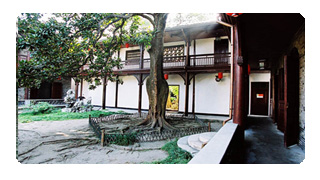 Heyuan
Garden
Heyuan
Garden
Heyuan Garden, located at the central section of Xunningmen
Street in the north bank of the ancient canal, is
originally named Jixiao Mountain Village. The garden
was built by He Zhidao,a high-ranking official during
the 9th year of Qing Dynasty Emperor Guangxu's reign(1883).
The garden consists of three parts: the rear garden
in the north; the courtyard in the center and a mixed
Chinese-Weste style field in the southeaste part.
This small garden has many ponds, pavilions, rocks
and poetically inscribed walls. There is a 430 meter
long walkway that winds through the whole garden linking
together many of the buildings. You can choose to
appreciate all this from a teahouse in the garden.
The Heyuan Garden is listed as a state protected cultural
relic.
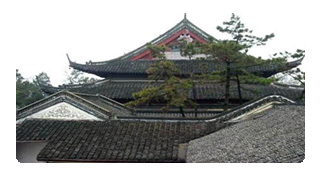 Daming
Temple
Daming
Temple
Daming Temple, located in the northweste suburb of
Yangzhou, is one of the oldest temples in the City
dating back over 1,500 years ago!
The temple's main hall, Mahavira Hall, contains three
Buddhist images; Yamuni in the center, the Master
of the Medicine in the East and Amitabha in the West.
An ancient decorated archway at the front of Daming
Temple stands prominently amidst old towering trees.
The archway bears the inscription 'Ruins of Xiling'.
During the Sui dynasty in 601 AD, a nine-story Xi1ing
Tower was built in the premises of Daming Temple.
Many famous poets of the Tang dynasty were inspired
by this tower to write moving poems. Sadly, the Xiling
Tower was reduced to ruins by a fire.
On the easte wall of the temple, there is an inscription
of Five big Chinese characters 'the First in Huaidong',
which means the Daming Temple is the best attraction
of Yangzhou. These are the words of a famous poet,
Qin Shaoyou, from the Northe Song dynasty, who taken
by the temple when he visited it.
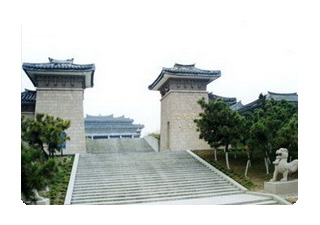 Museum
of the tomb of Han Guangling King
Museum
of the tomb of Han Guangling King
The Museum of the tomb of Han Guangling King, covering
a hilly area of 27,000 square meters, showcases the
tombs of Liu Xu, the first-generation Guangling King
of Yangzhou during the mid-Weste Han Dynasty (206
B.C-A.D. 24), and his wife. Both tombs were built
with the same quality and style as that reserved for
emperors. The tombs were well-preserved and in great
condition. Liu Xu's tomb occupies 230 square meters
and entirely built without a single nail. The museum
also displays many of the artifacts the couple used
while alive and was buried with.
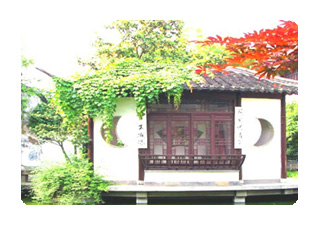 Erfen
Bright Moon Building
Erfen
Bright Moon Building
Erfen Bright Moon Building was built up in Mid Qing
Dynasty. It used to be own by Yuang Shi and later
Jia Songping, a merchant on salt. There is a wood
and a long list of seven buildings in the garden.
On the building hangs a plague with inscription of
"Erfen Bright Building" in Ming Dynasty.
The railings of the building are just for decoration;
the curved eaves on the top of the building are designed
in a unique artistic style. There are yellow stone
artificial rocks in the garden; ascending the pavilion
in the east of the garden by steps, you can appreciate
the fantastic scenery of mountains and lakes; the
lay out of the garden delivers an implicit and miraculous
atmosphere. It could be reputed as an exquisite design
of private garden in Yang Zhou. Walking into it, you
will first spot a corridor. The wall of the corridor
is made of bricks with carvings of primitive simplicity.
The seven buildings are sitting towards south. It
looks grand, towering, and majestic. Although the
original inscription by calligrapher Qian Yong fails
to be retained, his handwriting "Erfen Bright
Moon Building" in ink is still clear enough to
make out. The exquisite railings and long seats with
handrails add romance to the building. Accompanied
by the bright moon, you can experience the gentle
wind and a cup of delicious wine, enjoying to your
heart content the fantastic scenery of the garden.
The rockeries on the southeast of the garden are quite
amazing. A couplet of calligrapher, Wu Rangzhi, describes
the wonderful environment in front of the building
like this: Thousands of tourists come to visit the
fantastic garden in spring wind; the Bright Moon Building
is the best in Yangzhou. In the east of the yellow
stone rockeries stand three buildings. They are collectively
called Sun-setting Buildings because they face towards
west. In fact, the three buildings were built up on
the basis of Daxian Building. There is a plague on
them with inscriptions "Sun Set" by Zheng
Banqiao, a famous painter and calligrapher in Qing
Dynasty. The wall of the building up stairs is out
wonderful design, especially the engraved screens.
The bottom floor of the building is open and it is
equipped with yellow stone rockeries and artificial
lakes of clear water. In front of the hall lies an
open gazebo decorated with yellow stone chess table
and stone stools.
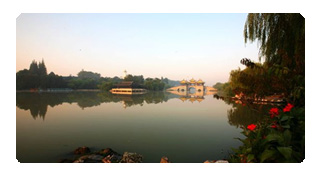 Slender
West Lake
Slender
West Lake
The Slender West Lake, located southwest of Yangzhou,
is a man-made lake with beautiful scenes and long
rich history. This state-level scenic resort got its
name from its shape, which resembles a slender, young
girl.
The resort is an elegant example of a Chinese lakeside
garden. Here, you will see a wide display of architectural
styles along the lake shore or even over the lake.
Most of the architecture is from the Qing dynasty
(1644-1911). Each is uniquely beautiful and contributes
to the area's rich literary culture of being written
about by many famous writers and poets.
The lake has 24 scenic attractions including the White
Pagoda, the Five Pavilion Bridge, Xiaojin Hill, Fuzhuang
and 24 Bridge.
Xiaojin Hill, the highest scenic spot on the lake,
offers a beautiful panorama of the lake. Fuzhuang
is surrounded by water and looks like it is floating
on the lake's surface. Here, you can purchase snacks
and enjoy performances held during festivals.
24 Bridge is the most famous attraction at Slender
West Lake. Built with white marble, the bridge is
24 meters (appox.79 feet) long, 24 meters (also appox.79
feet) wide, with 24 railing and 24 steps, which explain
its unique name. This bridge looks like a marble ribbon
or a rainbow grazing over the lake.
Other scenic areas are artistic kiosks, pleasant pavilions,
and small bridges. The area is beautiful like a scene
out of a fairy tale.
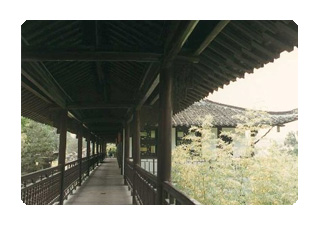 Geyuan
Garden
Geyuan
Garden
Geyuan Garden, located on the northe side of Dongguan
Street in Yangzhou city, was rebuilt by a local salt
industry official, General Manager Huang Zhiyun, in
the 23rd year of Qing Dynasty Emperor Jiaqing's reign
(1818). Bamboo leaves in the garden form the Chinese
character--(Ge) which is what the garden was named
after.
Geyuan Garden, the pinnacle of private gardens from
the Qing Dynasty, is a national cultural relic. The
architect of Geyuan Garden designed the rocks in the
garden in distinct shapes and colors that make this
garden beautiful and unique.



